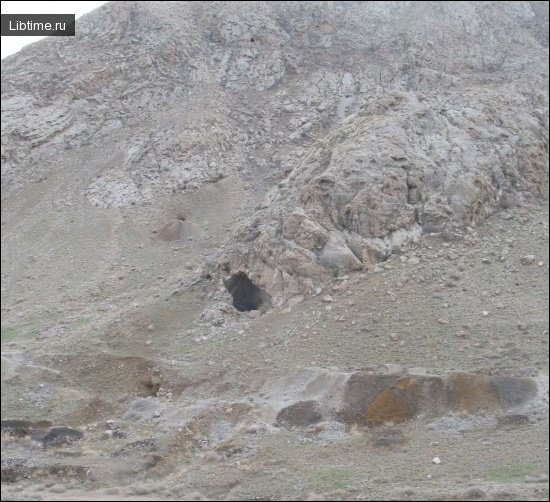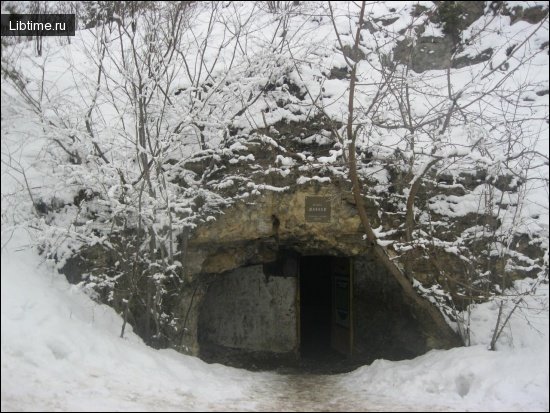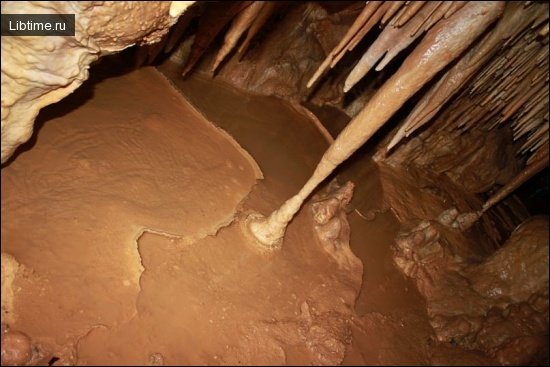Pamir-Tyanynan speleological country
Pamir-Tanynan speleological country covers the mountain systems of the south-east and east of Central Asia. Within its boundaries there are three speleological areas: Tanynan, Hissar-Alai and Pamir-Tajik. 
The largest of them Karasayskaya, located in the Karatau ridge, is 200 meters long. The Gissar-Alai region is divided into two speleological provinces Turkestan-Alai and Zeravshan-Gissar. Turkestan-Alai province includes the Turkestan and Alai mountain ranges, as well as their northern foothills.
Currently, 44 caves have been described here. Notable among them are Kan-i-Gut (3000 m long), Beshungur (315 m), Katranungur (157 m), Chilustun (140 m) and Baritovaya (over 100 m) caves.
Beshungur and Chilustun caves are located in the Osh Mountains, composed of Paleozoic limestone.
Beshungur cave (five caves) is located on the north-western slope of the Chil-Mayram ridge 14 km west of Osh city. It is characterized by a complex structure. A narrow (1 x 1.5 m) entrance, confined to a tectonic crack, leads to a cone-shaped well, which at a depth of 10 m widens and forms a platform up to 7 m long. From here there are five wells going downwards, which in some places turn into grottoes.
The total length of the cave is 315 meters. In the wells and grottoes there are well-developed natelic formations. The Chilustun cave (3 km northeast of Aravan) consists of two halls connected by passages. The large hall is 89 m long, 30 m wide and 3 m high. The cave is richly decorated with calcite deposits. Its total length is 140 m.
Of considerable interest is the Barite Cave, located in the northern foothills of the Alai Range in the middle reaches of the Aravan River. The ceiling and walls of the cave are covered with calcite and barite crystals. The length of the cave is more than 100 meters.
The Zeravshan-Gissar speleological province includes the Zeravshan, Gissar and Karategin ranges. It also includes the southwestern spurs of the Gissar Range, which west of the Gava Pass sharply changes its latitudinal direction to southwestern and branches into a number of ridges.
The caves are quite widespread. They are confined to carbonate rocks of the Paleozoic, Mesozoic and Paleogene, as well as to halogenic formations of the Upper Jurassic. Eighty-five caves and mines have been described within the province.
Major caves include Kapkotan (6000 m long), Karluk (1050 m), Yakkabag (600 m) and Amir-Temir (350 m).
The Kapkotan cave is excavated in Jurassic limestones. Its structure is determined by the peculiarities of tectonic fracturing. Gypsum and calcite formations are widespread. The air temperature is 20°. The total length of the cave is about 6000 meters.
Yakkabag cave is located on the right bank of the Kala River (left tributary of the Kyzildarya), 8 km south of Tashkurgan. It is laid in Upper Jurassic limestones. The entrance to the cave is located at a height of 150 meters above the river. There are several grottoes in the cave. The largest one reaches 100 meters in length, 20 meters in width and 30 meters in height.
In the far part of the cave there is a lake. It is 30 m long and 14 m wide. The cave is adorned with calcitic concretionary formations: stalactites, helictites and stalagmites. Its total length is about 600 meters.
The Amir-Temir Cave is located on the southern slope of the Karatube Ridge within the Amir-Temir intrusive massif containing lenses of limestone conglomerates. It was formed as a result of leaching of layers of crystalline bituminous limestone encased in a thickness of granites. The galleries of the cave are located on three levels.
The difference in height between the upper and lower levels reaches 45 meters. In the cave, there are concretionary formations in the form of stalactites and small stalagmites. The total length of the cave is 350 meters.
Of great interest is the Komsomolskaya mine, the deepest karst cavity in the mountainous part of Central Asia (Fig. 23). It is located on the Amankutan plateau and is a system of vertical passages with a total depth of 81 meters.
The Pamir-Tajik region is subdivided into two speleological provinces: West-Tajik and Pamir. The West Tajik province corresponds to the West Tajik depression, or the Tajik lowlands.
About 20 small caves have been explored here. The largest of them Khoja-Mumyn is located on the northeastern slope of the salt dome Khoja-Mumyn, at an altitude of 300-400 m above the Yakhsu River.
It looks like a corridor with width and height up to 8 m, along the bottom of which a stream with water flow rate of 15-20 l/sec runs noisily between the debris and blocks of salt. The length of the cave is 350 m. 
The Rangkul cave in the Salaktash gorge at an absolute height of 4400 m is of the greatest interest. It consists of four grottoes with wide and high passages. The total length of the cave is about 320 m, the far part of it is 100 m below the entrance.
The caves of the Turgai-Kazakhstan speleological country, covering Turgai and Central Kazakhstan, have been studied very poorly.
The Konuraulie cave, located on the right bank of the Shagan River, stands out among them. It was formed in marbleized limestone. The length of the cave is 120 m.


